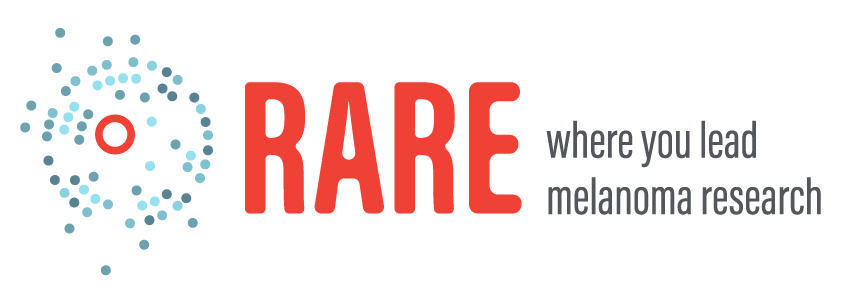
RARE Melanomas
A New Frontier in Melanoma Research
For Boris Bastian, MD, PhD, curiosity and an unwillingness to accept the status quo led to discoveries that have changed the melanoma field as we know it. Early in his career, Bastian, who is now the Gerson and Barbara Bakar Distinguished Professor in Cancer Research and Professor of Dermatology and Pathology at the University of California, San Francisco (UCSF), compared patterns of genomic alterations to clinical features and discovered a case that was very different from the others. “There were very striking genomic differences,” he says. The case turned out to be acral melanoma, a rare melanoma sub-type diagnosed in approximately 2,000-3,000 people in the U.S. each year.
At the time, the dermatology and oncology fields classified melanoma as a single disease. “Early on I realized that this notion that melanoma is one disease was not correct. Pathologists who tried to come up with classification distinguishing different melanoma types, based on where on the body they arose, how much sun the skin got, and how they looked clinically and microscopically were closer to the truth than this unifying concept,” Bastian explains.
Through his research, Bastian has been able to definitively show the genomic differences between the more common cutaneous melanoma (mainly caused by exposure to ultraviolet, or UV, rays) and the three rare sub-types of melanoma (acral, mucosal and uveal melanomas). Fast forward and these early insights are now well accepted within the field and Bastian is finishing up his involvement in the classification of melanoma in the World Health Organization’s (WHO) new edition of the Classification of Tumors.
Despite finding unique characteristics of rare melanomas, in particular acral and mucosal melanoma, much of how they work—and how to treat them—remains unknown. To address this, MRA has invested almost $20M in funding rare melanoma research, including two Team Science Awards led by Bastian. MRA also launched the RARE Registry, a direct-to-patient registry specifically focused on acral and mucosal melanomas, which form in areas of the body not typically exposed to sunlight (e.g., palms, soles, under fingernails/toenails, mucosal linings of different tissues).
Shedding Light on Rare Melanomas
The MRA RARE Registry Makes Strides
The RARE Registry is enabling MRA to make significant strides in understanding melanoma, specifically the two rare melanoma subtypes, acral and mucosal melanoma. While most melanomas develop on sun-exposed skin, roughly 5,000 people are diagnosed with acral or mucosal melanoma annually. Due to their location as well as a lack of awareness among the general public, dermatologists and other clinicians, these rare subtypes are often detected later, leading to poorer prognoses. Additionally, treatment options for these melanomas are more limited compared to cutaneous melanoma (the most common type of melanoma). The RARE Registry seeks to bridge this gap in knowledge and address the challenges faced by patients with acral and mucosal melanomas.
The RARE Registry aims to:
- Gather critical data: Through surveys, patients share their diagnosis journey, treatment history, lifestyle factors, and quality of life experiences.
- Empower patients: The registry provides real-time, de-identified insights gleaned from participants, fostering a sense of community and engagement in research.
- Inform research: Researchers gain invaluable insights into the unique biology and challenges of rare melanomas, paving the way for more effective treatments and better management of the diseases.
- Improve outcomes: By understanding these aggressive subtypes, researchers can develop different therapies and improve patient prognoses.


Addressing Racial Disparities in Melanoma Outcomes
Studies have shown that individuals of color, particularly those with acral melanoma, often experience poorer prognoses compared to their non-Hispanic White counterparts. “Racial disparities in melanoma outcomes are a significant concern,” says Vito Rebecca, PhD. Rebecca is an internationally known translational molecular biologist with a specialization in acral melanoma, an MRA Young Investigator Award recipient, a recent awardee of two grants from the Department of Defense Melanoma Research Program, as well as an Assistant Professor at Johns Hopkins Bloomberg School of Public Health. “By focusing on rare melanomas,” he says, “we can gain a better understanding of the underlying biological factors that contribute to these disparities and develop more equitable and precise treatment approaches.”
Rebecca’s research is actively contributing to what we know about rare melanoma subtypes. In February 2024, for example, Rebecca published the first paper ever to document how acral melanoma cells resist targeted therapy. “We feel it’s a massive accomplishment, but it’s also a very sad state of the field when this is the first paper to document a resistance mechanism and it’s 2024,” says Rebecca.
Like Bastian, Rebecca serves as a Scientific Advisor for the RARE Registry. He says, “The RARE Registry is a game-changer. It allows us to gather crucial data from patients with rare melanomas, which is essential for advancing research and improving treatment options. By understanding the unique characteristics of these diseases, we can develop more targeted and effective therapies.” And by unraveling the complexities of rare melanomas, the Registry will also help to address racial disparities in melanoma outcomes as we know it.
Dr. Vito Rebecca

Early Success and Future Direction
As of October 2024, the RARE Registry has enrolled over 340 participants, exceeding expectations and becoming the world’s largest registry for acral and mucosal melanoma. This includes 172 with mucosal melanoma, 95 with acral melanoma, and 73 with cutaneous melanoma (added in 2024 for broader data collection and comparisons to the more common type of melanoma).
Bastian and Rebecca emphasize the importance of the RARE Registry, which includes:
- Improved Disease Classification: By studying the unique features of rare melanomas, researchers can refine disease classification, leading to more targeted treatments.
- Enhanced Awareness: The registry raises awareness about the existence and distinct characteristics of rare melanomas, ensuring they are not overlooked.
- Fueling Research: The data collected will be a valuable resource for researchers to develop better diagnostic tools, treatment strategies, and ultimately, a cure for all types of melanoma.
Parallel efforts are ongoing to establish a biorepository collecting tumor and normal tissue samples from rare melanoma patients. This critical step will allow researchers to study more tissue samples and gain deeper insights into these rare cancers. This is particularly important because the rarity of these melanomas has traditionally interfered with securing enough samples for any given research study.
“Getting the word out about the existence and unique features of these rare melanoma subtypes is crucial,” says Bastian. “These efforts are so critical because they create a forum for people to get together and counteract these factors that otherwise impede progress.”
The Registry is a beacon of hope for patients with acral and mucosal melanomas and researchers dedicated to finding a cure for these devastating diseases. By empowering patients and fostering collaboration, the Registry is paving the way for a brighter future in melanoma research to study these rare subtypes. ![]()
Dr. Boris Bastian
